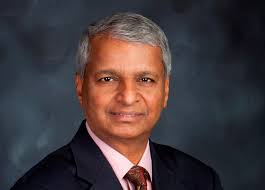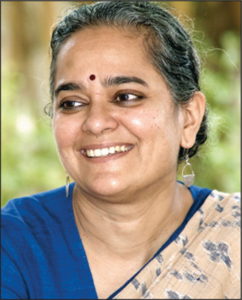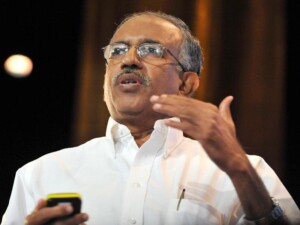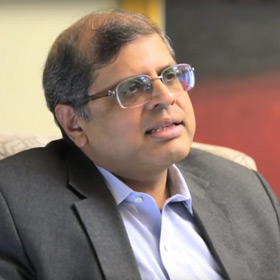Amit Chandra, MD of Bain Capital Private Equity, was hard hitting about how only by leading through the head, not heart alone, can Indian social sector make a significant impact. He said “ideas are overrated, perseverance and execution excellence make all the difference.” Amit was one of the key speakers at Development Dialogue at Huballi early February. Here’s a synopsis of his views on scaling and big impact challenges facing the social sector:
“What is missing is audacity of goals in the social sector like it’s there in the corporate world.
People need to think hard about how they will organize their organizations. Often social sector organizations are very lonely and depend on one person. It’s very difficult for one person to scale and build up. They need to go and attract talent and not try to do everything alone.
Social sector leaders need to think a lot about process, scalability, monitoring, and impact measurement among other things. The problem among them is that there isn’t enough head, there’s a lot of heart. That’s were a lot of them tend to falter.
I believe that ideas are massively overrated. My experience is that it is perseverance and execution that carries you forward. Consider failure as your best friend.
To fill this gap our foundation undertakes capacity building through programs. They are Dasra AP (Accelerator Potential), and Dasara LP (leadership potential). We send 5 to 10 exceptional leaders to Harvard Business School to work with social leaders across the world. It’s called Mother Teresa fellowship.
Our theory is that India needs at least 1000 exceptional social sector leaders to drive a significant change. We try to build 250 leaders a year.”
Amit and his wife Archana saved their income for nearly two decades and run a philanthropic foundation.
Collaboration only way to scale
 Desh Deshpande, founder of Deshpande Foundation, said collaboration and big bets is about how to connect different kinds of people and organizations together so that we can solve society’s problems.
Desh Deshpande, founder of Deshpande Foundation, said collaboration and big bets is about how to connect different kinds of people and organizations together so that we can solve society’s problems.
“The new conversation is, what is the interface that we need between system thinkers, people with resources, people who can work on government policies? How do we bring these capabilities to find solutions for those who earn 2 dollars a day? How do we bring new ways of thinking, and if some things are working, how can we scale up?
Even one of the most successful Indian NGOs Akshaya Patra does 1.6 million midday meals a day for school children. The challenge is, how can we take it to 100 million children. The problem in India is even if we have good solutions, we don’t know how to scale them.”
The Hubballi Development Dialogues (www.developmentdialogue.org) is India’s premier networking event for people associated with the social sector in India. It gets top speakers and highly motivated participants.
Regulations still binding micro sectors
 Mirai Chatterjee, Director, Self-Employed Women’s Association (SEWA), is perturbed because India’s economic reforms since 1991 has worked only for the big businesses and that the micro or the unorganized sectors still reel under the burden of regulations.
Mirai Chatterjee, Director, Self-Employed Women’s Association (SEWA), is perturbed because India’s economic reforms since 1991 has worked only for the big businesses and that the micro or the unorganized sectors still reel under the burden of regulations.
“Formula in SEWA – If you run a project properly for 3 to 4 years it will be good; if you run for 10 years you can build an institution; If you run for 20 years, it becomes a movement. SEWA is now 50.
SEWA’s secrets – Innovate, develop your own bank and insurance. The big learning is we started ourselves, uniting women, find our own solution. Just like sandbox. Not discouraged by shut doors from the government.
Entrepreneurship has to be collective, especially for women. It makes it easier for firms to partner with them. Collaboration and partnerships reasons for success of SEWA.”
Mirai Chatterjee has dedicated her life to recognizing and supporting self-employed women in India.
We give away everything we have
 Only an open source system with willingness to share knowledge and practice with the world can help in achieving dramatic scale, Thulasiraj Ravilla, Executive Director, Lions Aravind Institute of Community Ophthalmology, said.
Only an open source system with willingness to share knowledge and practice with the world can help in achieving dramatic scale, Thulasiraj Ravilla, Executive Director, Lions Aravind Institute of Community Ophthalmology, said.
The open secret of Aravind’s Eye Care revolution and achieving 3.1 million patients a year, he said is: “Fostering competition among ourselves as a strategy and become like an open source organization. We give away everything we have including best practices and technology.”
Started in Aravind Eye Care today runs 350 hospitals around 30 countries and does half a million surgeries. “With very little investment we are able to influence one million surgeries a year world over,” he said.
“You have to keep the goal beyond yourself. If you keep it to yourself you only come up with incremental efficiencies. You can disrupt only if you think beyond yourself. We did that when we decided that every person should get an affordable lens. We were able to disrupt the intraocular lens market by bringing down cost of lens from $100 in 1992 to $10 and to $ 2 today. This can happen if one is driven by purpose and passion.”










